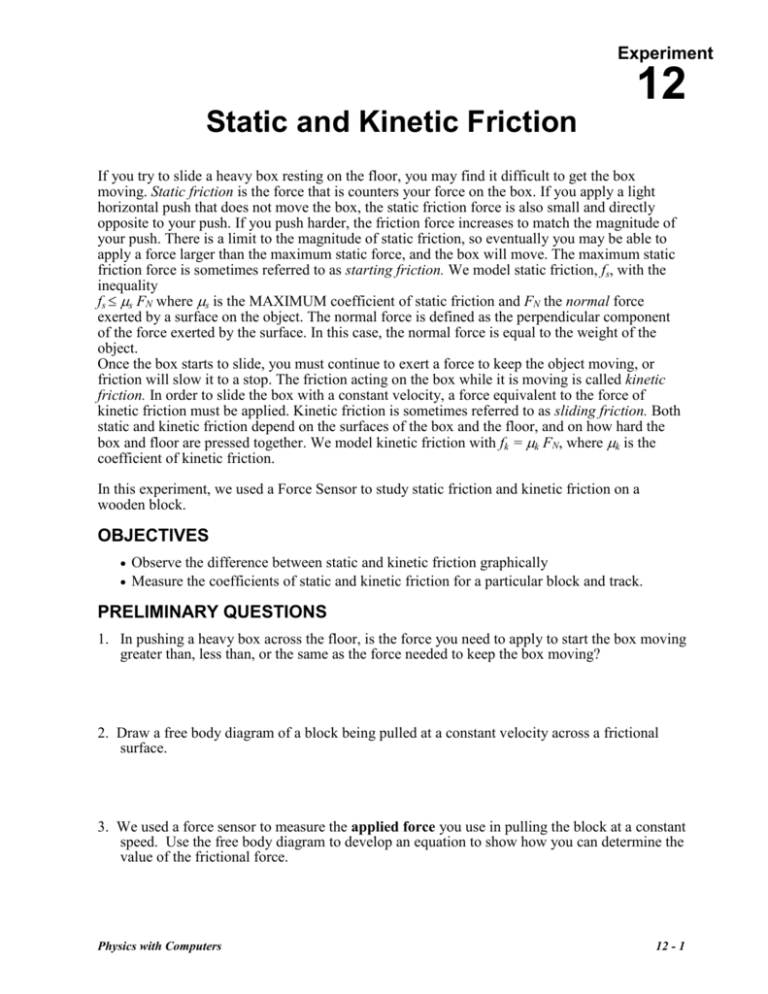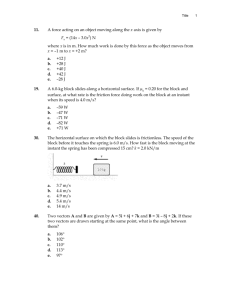12 Static Friction (make up)
advertisement

Experiment 12 Static and Kinetic Friction If you try to slide a heavy box resting on the floor, you may find it difficult to get the box moving. Static friction is the force that is counters your force on the box. If you apply a light horizontal push that does not move the box, the static friction force is also small and directly opposite to your push. If you push harder, the friction force increases to match the magnitude of your push. There is a limit to the magnitude of static friction, so eventually you may be able to apply a force larger than the maximum static force, and the box will move. The maximum static friction force is sometimes referred to as starting friction. We model static friction, fs, with the inequality fs s FN where s is the MAXIMUM coefficient of static friction and FN the normal force exerted by a surface on the object. The normal force is defined as the perpendicular component of the force exerted by the surface. In this case, the normal force is equal to the weight of the object. Once the box starts to slide, you must continue to exert a force to keep the object moving, or friction will slow it to a stop. The friction acting on the box while it is moving is called kinetic friction. In order to slide the box with a constant velocity, a force equivalent to the force of kinetic friction must be applied. Kinetic friction is sometimes referred to as sliding friction. Both static and kinetic friction depend on the surfaces of the box and the floor, and on how hard the box and floor are pressed together. We model kinetic friction with fk = k FN, where k is the coefficient of kinetic friction. In this experiment, we used a Force Sensor to study static friction and kinetic friction on a wooden block. OBJECTIVES Observe the difference between static and kinetic friction graphically Measure the coefficients of static and kinetic friction for a particular block and track. PRELIMINARY QUESTIONS 1. In pushing a heavy box across the floor, is the force you need to apply to start the box moving greater than, less than, or the same as the force needed to keep the box moving? 2. Draw a free body diagram of a block being pulled at a constant velocity across a frictional surface. 3. We used a force sensor to measure the applied force you use in pulling the block at a constant speed. Use the free body diagram to develop an equation to show how you can determine the value of the frictional force. Physics with Computers 12 - 1 Experiment 12 4. Use the free body diagram to develop an equation to show how to calculate normal force (which is part of the friction equation). PROCEDURE 1. The following set up was used: Mass Wooden block Dual-Range Force Sensor Pull 2. During the first set of data, the wood block was pulled without the mass and for the subsequent sets of data, a mass was placed on top of the block. The surface used was a plank of wood. 3. When the block was pulled, it made a graph similar to the one pictured in #1 of the Analysis questions. You can see graphically where the static friction force is growing, then it peaks and the block begins to move. You can see that the kinetic friction is lower than the peak static friction as we pull the block at a constant velocity the rest of the way down the board. 4. Various values of peak static friction and kinetic friction were obtained in placed in the data table for you. 5. Use the equation you determined in preliminary question #4 to calculate the normal force and enter the values in the data table. 6. You can see in the data table that 3 trials were run with the block by itself, then with a 1 kg mass attached, then with a 2 kg mass attached. Determine the average friction force for each trial. 12 - 2 Physics with Computers Static and Kinetic Friction DATA TABLE Mass of block Total mass (kg) Normal force (N) Trial 1 0.342 kg Peak static friction Trial 2 Trial 3 0.342 1.542 1.369 1.469 1.342 3.946 3.554 3.828 2.342 5.433 5.102 5.112 Trial 1 Kinetic friction Trial 2 Trial 3 0.342 0.869 0.944 0.905 1.342 2.998 3.015 3.027 2.342 4.865 4.389 4.807 Total mass (kg) Normal force (N) Average maximum static friction (N) Average kinetic friction (N) ANALYSIS 1. Here is an actual graph that was made using the procedures above. Inspect the force vs. time graph. Label the portion of the graph corresponding to the block at rest, the time when the block just started to move, and the time when the block was moving at constant speed. 2. Still using the force vs. time graph you created in Part I, compare the force necessary to keep the block sliding compared to the force necessary to start the slide. How does your answer compare to your answer to question 1 in the Preliminary Questions section? Physics with Computers 12 - 3 Experiment 12 3. If you look at the equation fs = µsFN, you should notice that it has the form y = mx, where y is represented by fs, x is represented by FN, and m (the slope) is represented by µs. If you graph the average maximum static friction force (vertical axis) vs. the normal force (horizontal axis), and draw a best fit line, then the slope of this graph is the coefficient of static friction, s. Get some graph paper and plot your points and determine your line of best fit. Pick two good points and find the numeric value of the slope, µs, including any units. Show your calculations here. 4. Now make another graph to find the coefficient of kinetic friction k. (Repeat question 3— just use kinetic numbers instead of static.) Show your calculations here. (Make sure to attach your graphs when you submit your lab report.) For #3 and 4, there are a few options available to make things easier. Instead of calculating the slope, you can put the data into a calculator to get a best fit line. Or you can use my computers and use Logger Pro to create the graphs and use a line of best fit to determine the slope. 12 - 4 Physics with Computers



